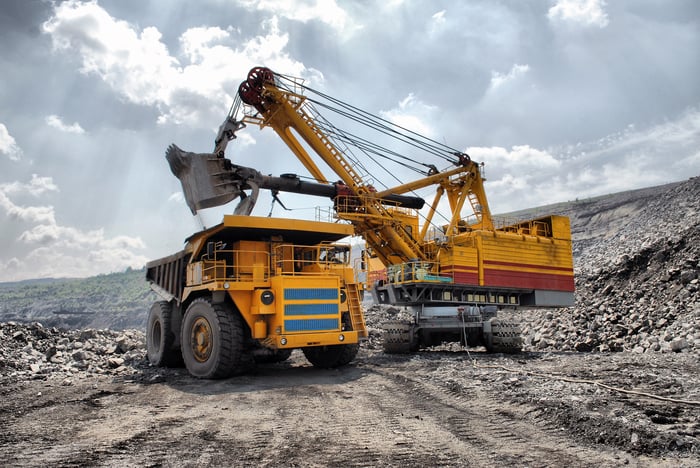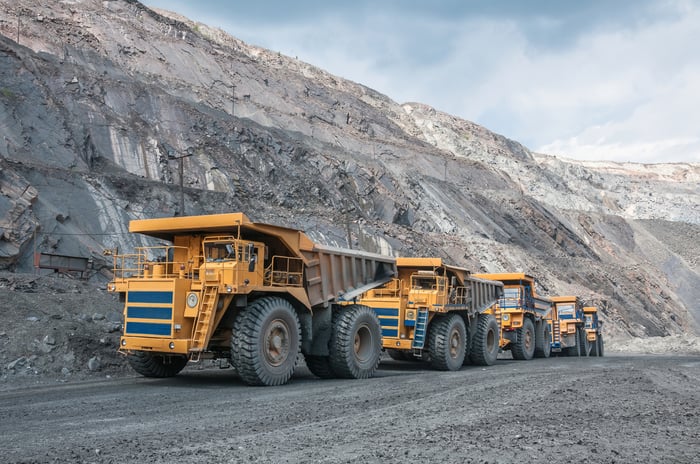Since the beginning of 2016, gold stocks have been among the markets' top-performing industries. After the lustrous yellow metal tipped the scales at $1,050 per ounce in early 2016, it has since rebounded to about $1,290 an ounce. Following a four-year downtrend, gold is officially back in a bull market, and many of the companies that mine it have benefited in a big way.
The importance of all-in sustaining costs
However, not all gold stocks are created equally, and as you might have rightly surmised, some have performed better than others. While there are a number of factors that can influence how well or poorly a gold miner performs, including geographic location, ore grade, and the recovery rate of mined material, there's perhaps no more important metric for gold stock investors than all-in sustaining costs, or AISC.

Image source: Getty Images.
All-in sustaining costs take into account the pertinent costs of mine maintenance (on-site mine and administrative costs, royalties and production taxes, byproduct credits, permitting costs, smelting, refining, and transport) as well as behind-the-scenes costs that aren't often associated with on-site mining but still factor into overall expenses. These include corporate general and administrative costs, sustaining exploration and study costs, sustaining capitalized stripping and underground mine development, and sustaining capital expenditures, to name a few.
Long story short: You get a pretty encompassing picture of which mining companies are producing the best and worst margins by utilizing the AISC measure.
Three gold miners with the lowest AISC
Let's take a closer look at how 10 of the largest gold-mining companies are performing based on the midpoint of their full-year AISC forecast. We're going to exclude royalty and streaming companies such as Royal Gold and Franco-Nevada for the purposes of making an apples-to-apples comparison, as well as remove any large gold miners that report only on a cash cost and not AISC basis, such as Randgold Resources.
- Barrick Gold (GOLD 1.68%): $745 an ounce.
- Newmont Mining: $970 an ounce.
- Goldcorp (GG): $850 an ounce.
- Agnico Eagle Mines: $875 an ounce.
- AngoGold Ashanti: $1,075 an ounce.
- Kinross Gold: $975 an ounce.
- Gold Fields: $1,020 an ounce.
- Yamana Gold: $900 an ounce.
- B2Gold: $955 an ounce.
- Eldorado Gold (EGO -0.40%): $860 an ounce.
You'll note that all of these gold miners have done a good job of reducing their costs over the past five years as gold prices have retreated from nearly $1,900 an ounce back in 2011. If gold were to remain near $1,300 an ounce, all 10 of these mid- and large-cap gold-mining stocks would be healthfully profitable.
Nonetheless, there are three clear standouts.

Image source: Getty Images.
1. Barrick Gold
Far and away the most cost-efficient large miner is Barrick Gold, with a midpoint of its 2017 AISC forecast of $745 per ounce. Barrick wound up lowering its AISC forecast on three separate occasions in 2017, leaving this Fool to believe that the company could indeed be a bit conservative with its cost guidance.
Barrick Gold has two major factors working in its favor. First, it's really taken the time to focus on reducing its capital expenditures and debt. At the end of 2014, the company had $13.1 billion in debt, but by the end of 2016, Barrick had reduced its total debt to $7.9 billion. By 2018, Barrick anticipates reducing its debt to just $5 billion, which means lower interest expenses and more flexibility should it feel the need to acquire new properties. As a bonus, less than $200 million of its remaining debt matures before 2019.
In terms of capital expenditures, Barrick came in under target in 2016 at $1.12 billion, and the company has lowered its capital expenditures by about $225 million in 2017 and 2018 from its initial guidance. This, too, can have a positive impact on AISC.
The other factor working in its favor is the potential for organic mine expansion. For example, the Goldrush mine in Nevada is expected to add an estimated 440,000 ounces of gold a year by 2021. Meanwhile, Turquoise Ridge is expected to see an expansion of its underground mine. These are just two of many examples where Barrick can boost its output without affecting its AISC all that much.

Image source: Getty Images.
2. Goldcorp
For those of you who regularly follow gold stocks, seeing Goldcorp among the most cost-efficient miners should come as no surprise. Goldcorp has long had a focus on boosting efficiency, being prudent with its capital expenditures, and utilizing its byproducts to offset its gold-mining costs.
Last year, Goldcorp wound up lowering its AISC to $856 an ounce, which was notably lower than the $894 reported in 2015. Goldcorp has managed this about-face by focusing on its most promising projects and looking for ways to reduce its costs organically. For instance, it's been analyzing its properties in an effort to save $250 million annually in cost savings by 2018. Thus far it's identified about $150 million in savings and wound up realizing $100 million in annual savings last year.
At the same time, Goldcorp is focused on ramping up production at Cerro Negro in Argentina and Eleonore in Quebec. After producing 382,000 gold ounces at Cerro Negro last year, Goldcorp is targeting an additional 28,000 ounces in 2017, largely a result of development rate improvements. At Eleonore, production is estimated to grow by a double-digit percentage to 315,000 gold ounces from 278,000 in 2016, as the company continues to ramp up operations. Full production isn't even expected at Eleonore until sometime in 2018.
Significant byproduct recoveries at Musselwhite, Eleonore, Penasquito, Red Lake, and Cerro Negro have also been instrumental in keeping Goldcorp's costs down. I'd expect it to remain a low-cost leader within the industry.

Image source: Getty Images.
3. Eldorado Gold
Eldorado Gold is another mining company that surprised Wall Street last year by producing an AISC of $900 an ounce versus its original AISC guidance of $940 to $980 an ounce.
What we're seeing right now is a major transformation under way with Eldorado Gold. The company disposed of its non-core assets in China last year, selling its 82% stake in Jinfeng, and closing its sales on both White Mountain and Tanjianshan in November. The sale better helps Eldorado Gold focus on its core mines in Greece and Turkey, as well as prepare for the start of commercial production at Skouries in Greece by 2019.
Gold and copper mine Skouries has the potential to be a real game-changer for Eldorado. After multiple delays, construction of the mine is underway and, at least for now, on track. The company expects to spend $170 millon to $200 million on capital expenditures at Skouries this year, which is lower than it forecast back in September. The company attributes the flexibility of its capital plan and ongoing cost initiatives for helping to push its spending below budget.
Once online, Skouries is expected to have an estimated 25-year lifespan that'll wind up producing more than 3 million ounces of gold and close to 1.5 billon ounces of copper. In fact, the copper byproduct during the first nine years of the mine is expected to push its sustaining and operating cash costs into the negative.
Most importantly, Eldorado ended 2016 with $883.2 million in cash and cash equivalents following the divestiture of its non-core assets. In just one year's time it went from a $300 million net debt position to more than a $290 million net cash position. This added flexibility should be a good thing for the company and shareholders.





